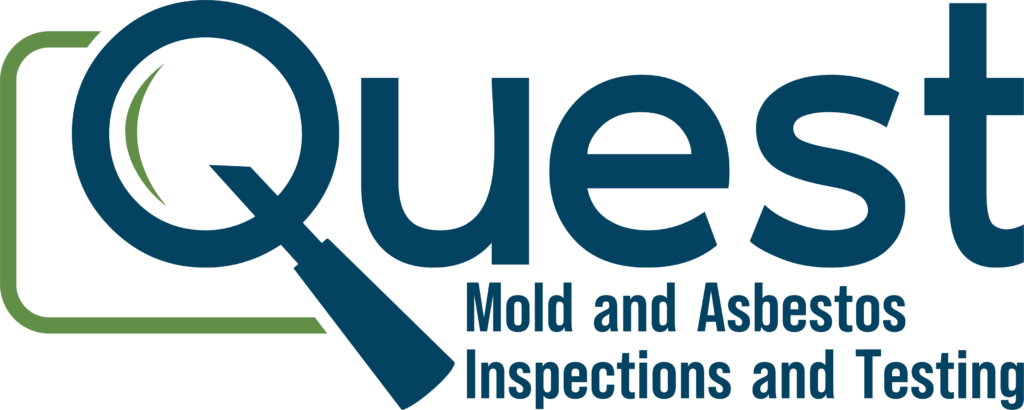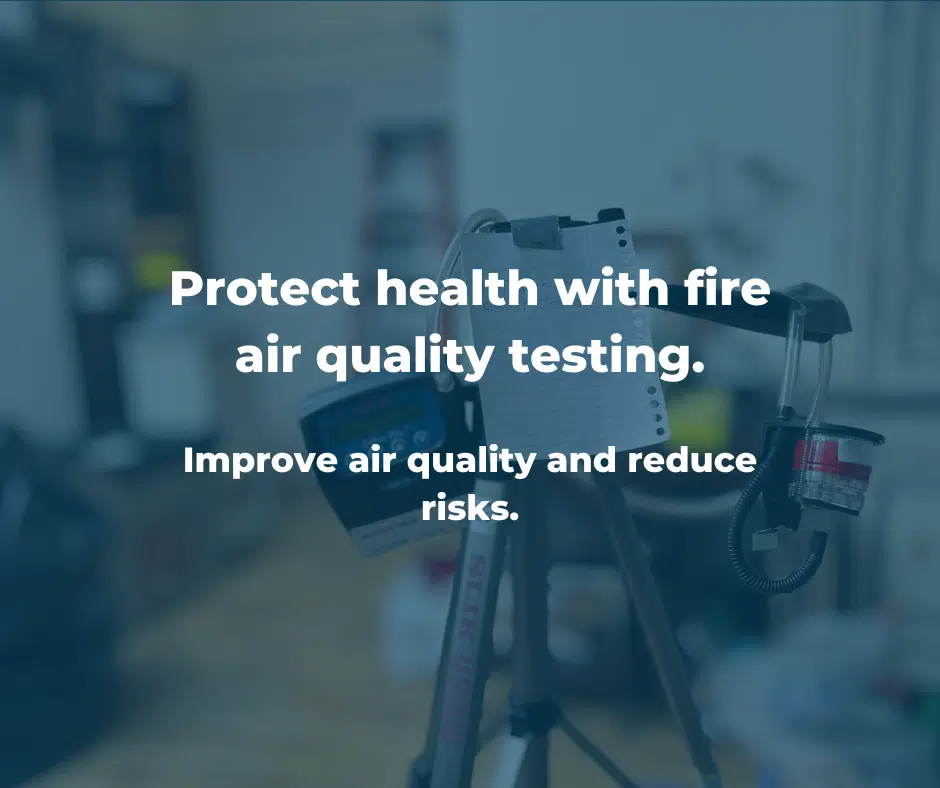Make sure your property’s air is safe after fire damage with Quest Mold and Asbestos Inspections and Testing. Using Fire Air Quality Testing, we identify dangerous impurities including particulate matter, carbon monoxide, VOCs, etc., to ensure the health of employees and occupants.
We know how critical it is to keep a healthy environment across properties, especially after a fire damage, and we are here for you. Whether a residential home, commercial building, school, or place of worship, fire damage will in most cases leave dangerous contaminants that pose a serious health risk to occupants and workers during cleanup and restoration.
With our new Fire Air Quality Testing service, we aim to identify these risks and mitigate them by testing for harmful substances that can be present in air even well after the flames have died down.
What We Test For in Fire Air Quality Testing
Pollutants from fires can be dangerous to your health. After a fire, particles and gases that result can lead to both immediate and long-term health effects. The tests we provide under our Fire Air Quality Testing service cater to assessing:
1. Particulate Matter (PM2. 5 and PM10)
Particulate Matter (PM2. 5 and PM10) are tiny particles that float in the air and are usually smaller than 10 micrometers (PM10) and 2.5 micrometers (PM2. 5). These particles are so small that they can be inhaled deep in the lungs.
PM 2.5 can worsen respiratory diseases, including asthma, bronchitis and other lung conditions. High levels of PM2. 5 and PM10 play a part and can lead to longer-term cardiovascular and respiratory problems.
2. Carbon Monoxide (CO)
Carbon monoxide is an invisible, odorless gas that results from the incomplete burning of carbon-based materials such as wood, paper and construction materials.
CO is toxic and can lead to harm through increased inhalation, leading, in severe cases, to head pain, incoherency, and fatality. It can remain in the air after a blaze has been put out, particularly if the fire was not well ventilated.
3. Volatile Organic Compounds (VOCs)
VOCs are toxic chemicals that are emitted into the atmosphere when many materials are burned, including paints, plastics, fabrics and adhesives.
It can irritate the eyes, nose and throat, cause headaches and lead to chronic health issues like liver and kidney damage. Some VOCs are linked to cancer and neurological problems, too.
4. Polycyclic Aromatic Hydrocarbons (PAHs)
Polycyclic aromatic hydrocarbons, or PAHs, are a group of chemicals that are formed when organic matter, like wood, tobacco and fossil fuels, is burned incompletely.
Many PAHs are carcinogenic — meaning that they can raise the risk of cancer. They can also effect the skin, liver, and immune system, which is why it’s important to test for them after a fire.
5. Formaldehyde
A chemical used in many building materials, including insulation, plywood and particleboard. It is also released when things like furniture and carpeting burn.
Exposure to formaldehyde over a short period may cause eye irritation, while exposure over long periods can cause respiratory problems and an increased risk of cancer.
6. Asbestos Fibers
Asbestos is a naturally occurring mineral that became widely used in construction materials until its health hazards were discovered. If these asbestos-containing materials are disturbed in the event of a fire, fibers can be released into the air.
Asbestos testing absolutely needs to take place after a fire to ensure that no disturbed asbestos containing materials threaten human health.
7. Mold Growth Indicators
Firefighting efforts after a fire often result in water damage, leaving a perfect breeding ground for mold. We check for signs of mold growth in the air and on surfaces.
Mold can trigger allergic reactions, respiratory issues and other health problems, especially in those with weakened immune systems. Since mold also deteriorates the structural condition of your property, the sooner you discover it because of any fire damage restoration, the better.
Why We Test: Fire Air Quality Testing
Toxic contaminants can fill the post-fire environments and have serious health risks. This is why a fire air quality testing service can be instrumental in identifying such hazards and determining whether or not a property is safe to return to after a fire. Below are the main reasons we test for this vital knowledge:
1. For Safe Air Quality for Occupants and Workers
After a fire, air quality can be dangerously affected and the hazards can affect anyone who is coming back into the property, including firefighters, restoration personnel, and residents. Testing the air can help us detect any harmful particles, gases, or chemicals that may be present. By using it, we can make the air safe for anyone who has to work or reside in the building.”
2. To Detect and Curb Health Risks From the Residual Toxins
Fires emit a huge array of toxic chemicals and particles that can remain in the environment well after the flames have been extinguished. Without identifying what may be found, these substances can lead to respiratory issues, skin irritation, and other health problems. Our testing identifies these residual toxins so they can be properly addressed before anyone is exposed.”
3. To Meet Regulatory Requirements for Cleanup and Restoration Projects
There are often strict rules on air quality after a fire. Restoration and cleanup efforts must be done according to local, state, and federal guidelines to ensure the building is safe for reoccupation. Use our Fire Air Quality Testing service, which will give you the information you need to prove your land is safe and fulfill the regulations.
4. To Support Insurance Claims and for Restoration Plans Data
Insurance claims also sometimes require in-depth reports on the state of the property after fire. This is where our Fire Air Quality Testing service can help—providing critical data that supports your claim so you can show what damage was done, and what actions were taken to restore the home or building. This data is also essential for a robust restoration plan to ensure air quality impacts are being fully addressed.
Why Quest Mold and Asbestos Inspections and Testing
With a dedicated, family-owned and operated business, we ensure personalized, top-notch services, and put the safety and health of their clients first. Here’s why you can count on Quest Mold and Asbestos for your Fire Air Quality Testing:
- Testimonials and Ratings: Highly rated molds, asbestos, and air quality testing specialists. We know the challenges of post-fire land and utilize cutting-edge apparatus to ensure full testing and accurate results.
- Axelrods Testing Services: Conduct ca omprehensive range of testing, including particulate matter, VOCs, mold growth indicators, and airborne asbestos fibers. This ensures you can take care of all potential health issues.
- Family-Oriented Service: We are a family-owned business, and we treat our clients as family. We are with you every step of the way to ensure your property is safe and ready for re-occupation.
Conclusion
Fire damage doesn’t stop when firefighters extinguish flames. Residual toxins and contaminants can be dangerous, so air quality testing is critical to creating a safe environment. Fire Air Quality Testing at Quest Mold and Asbestos Inspections and Testing. Contact us today to find out more about our services and to book your inspections.
Take care and leave the rest to us!


